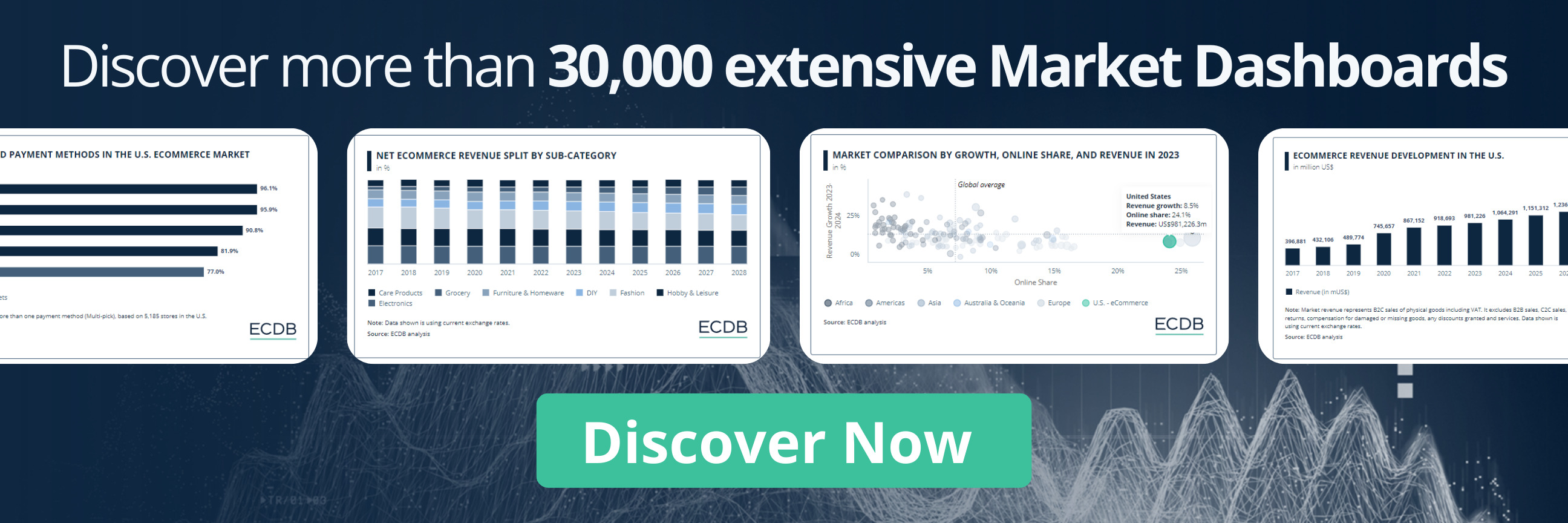eCommerce: Business-to-Business (B2B)
The Global B2B eCommerce Market: Why It Is Beneficial to Sell to Other Businesses
B2B (business-to-business) eCommerce is a growth market with promises of high margins. What is behind this sector of global eCommerce? Learn about market GMV, leading regions, and benefits of selling to businesses online.
Article by Nadine Koutsou-Wehling | October 16, 2024Download
Coming soon
Share

B2B eCommerce Market: Key Insights
Market Growth: In 2024, the global GMV of B2B eCommerce is expected to reach US$26.6 trillion, which is equivalent to the GDP of the United States. Its growth is projected to continue in the following years.
Regions and Players: APAC is the world region with the highest revenues in B2B eCommerce. Within APAC, China leads the sector. However, Amazon Business is the number one B2B player. Despite its dominance, there is room for other retailers to grow.
Benefits of B2B eCommerce: Reasons for businesses to sell to other businesses include cost savings, revenue stability, traceability of the customer experience, and higher retention potential.
B2B (business-to-business) eCommerce is increasingly being recognized as a high-growth market, with promises of rising margins for businesses that are usually constrained by fluctuating consumer demand and rising costs.
Yet, despite the increased focus, this sector of the online market is often underappreciated. Is it indeed more profitable than B2C (business-to-consumer) eCommerce?
Learn more about global B2B eCommerce and its advantages.
What Is B2B eCommerce?
Business-to-business (B2B) eCommerce is the wholesale sector of the online economy, where companies sell products or provide services to other companies online. Other models include B2C and D2C. For a more thorough distinction between the three, kindly visit my colleague Cihan’s in-depth illustration of the matter.
Like consumer-facing eCommerce, B2B eCommerce distinguishes between stores and marketplaces. In the direct model, a company operates its own online platform to reach other businesses. A B2B marketplace is a platform where many businesses sell to other businesses. Platform providers make a profit by charging a fee per sale. Value-added services are another common income source.
The B2B eCommerce Market
The global B2B eCommerce market is seeing trillions of dollars in marketplace transactions. For comparison, the United States’ GDP is US$28.8 trillion in 2024.
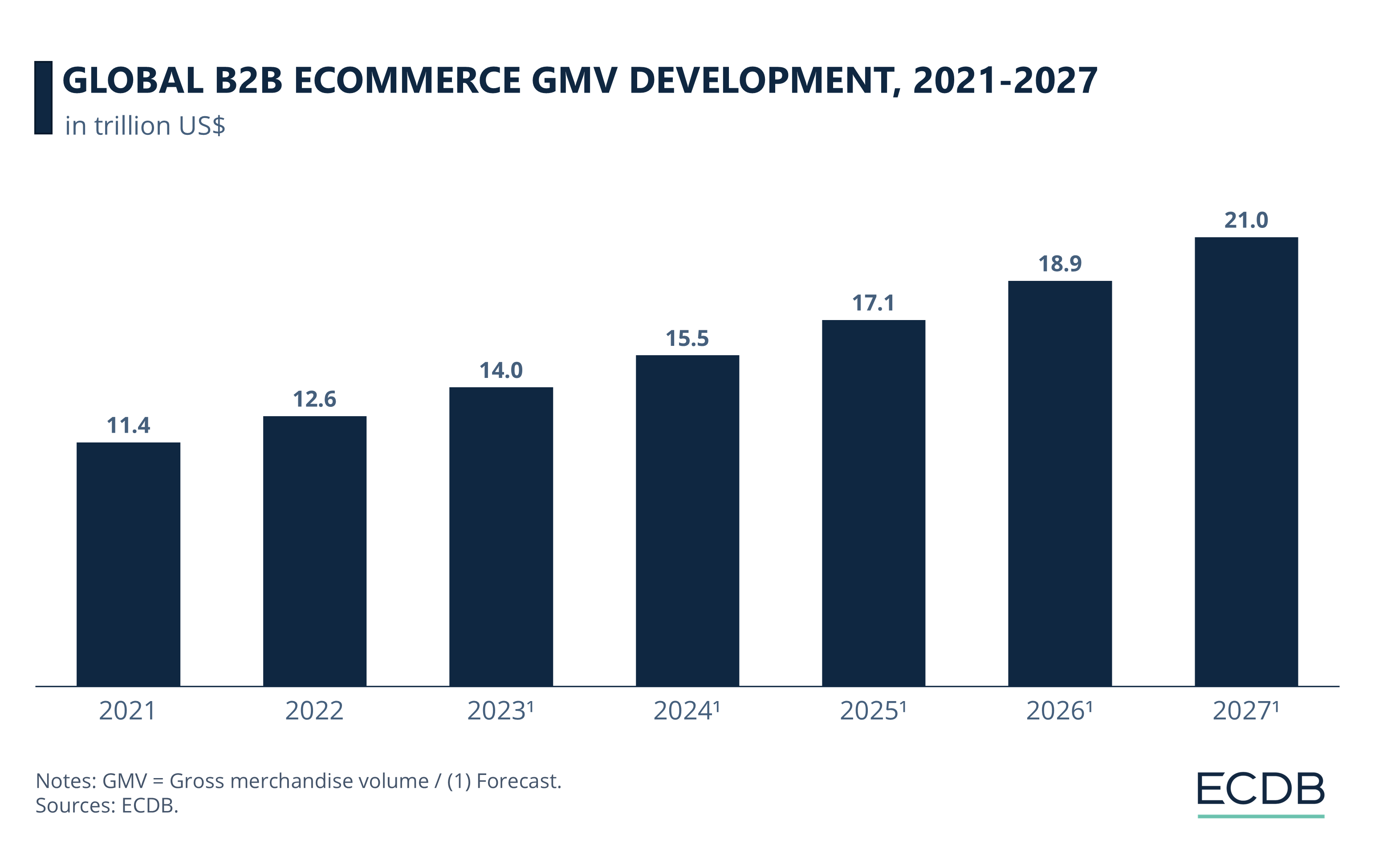
Global B2B eCommerce GMV has been growing steadily and is expected to continue on its steady path through 2027.
In 2023 and 2024, global GMV of B2B eCommerce is projected to be US$14 trillion and US$15.5 trillion.
From a regional perspective, APAC (Asia-Pacific) contributes the largest share to the global GMV of B2B eCommerce. Other regions lag behind, with North America coming in second, but at a much lower level.
Within APAC, China is the largest market for B2B eCommerce. It is followed by Japan and India. The reason for their advanced adoption of online B2B commerce lies in the largely untapped nature of their B2B markets, which has allowed companies to build B2B eCommerce structures more easily. In a highly structured business environment like Europe, where many of the offline B2B business processes are predetermined, it is much more complicated and costly to move operations online.
Staying with this aspect for a bit longer, let's see what the B2B eCommerce market in APAC has to offer participants.
B2B eCommerce Initiatives in APAC
National governments in APAC have recognized the potential of B2B eCommerce and are taking active steps to promote its development. Here is what this means for specific countries.
Myanmar: The government has developed a centralized eCommerce platform to enhance online trade. It offers a Good Practice Guide for merchants to familiarize themselves with the market.
Singapore: Singapore’s Commodities Intelligence Center (CIC) introduced the country’s first global B2B e-trade platform. It partners with leading B2B eCommerce platform ZALL.
Vietnam: Launched its first B2B eCommerce platform called Telio in 2019. It connects small retailers with brands and wholesalers on a centralized platform.
Indonesia: With the launch of platforms like Grab Kios, GudangAda, and GoToko, the market is one of the preferred spots for venture capitalists in Southeast Asia.
Malaysia: The Malaysian Digital Economy Corporation, in partnership with Alibaba Cloud, has launched the City Brain initiative to support digital transformation.
The last point already hints at something important: Alibaba’s role in B2B eCommerce extends beyond its home market of China to include international markets. It is therefore the leading player in APAC as a whole.
Major eCommerce Companies Have Their B2B Division in Place: Alibaba & Amazon
Alibaba is not only China’s most influential eCommerce company. Through heavy investment and smart foresight, it manages to support other companies' business operations through B2B eCommerce.
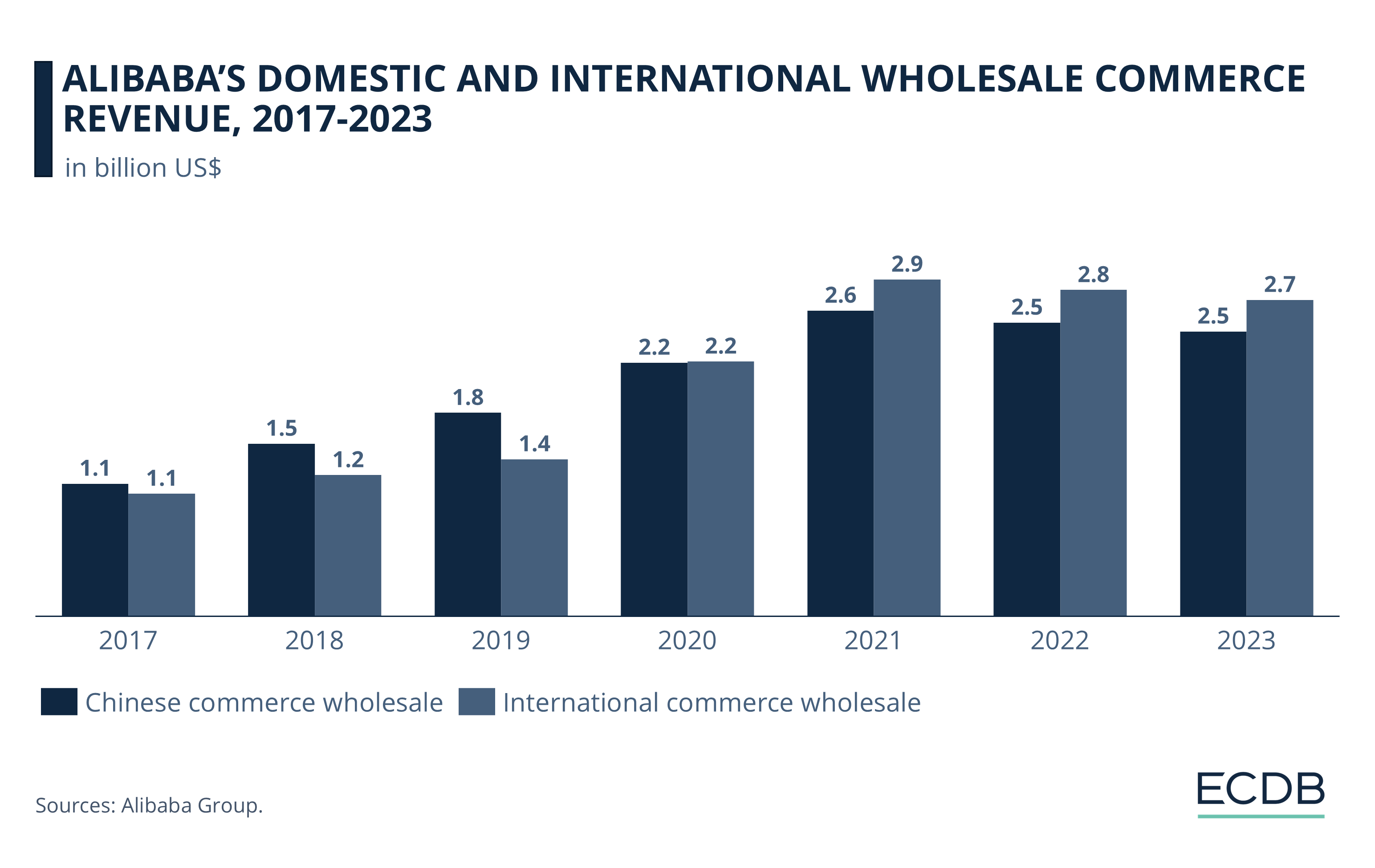
In 2021, international wholesale trade surpassed Alibaba's domestic counterpart.
The company's latest annual earnings report in 2023 shows slight declines in both sectors, but international wholesale still outperforms the domestic B2B industry by about US$200 million.
One company is outpacing all the others in B2B eCommerce. Amazon Business generates the most revenue. Amazon Business is the wholesale version of Amazon, offering quantity discounts and spending analytics for corporate customers. There is also a Prime subscription for Amazon Business.
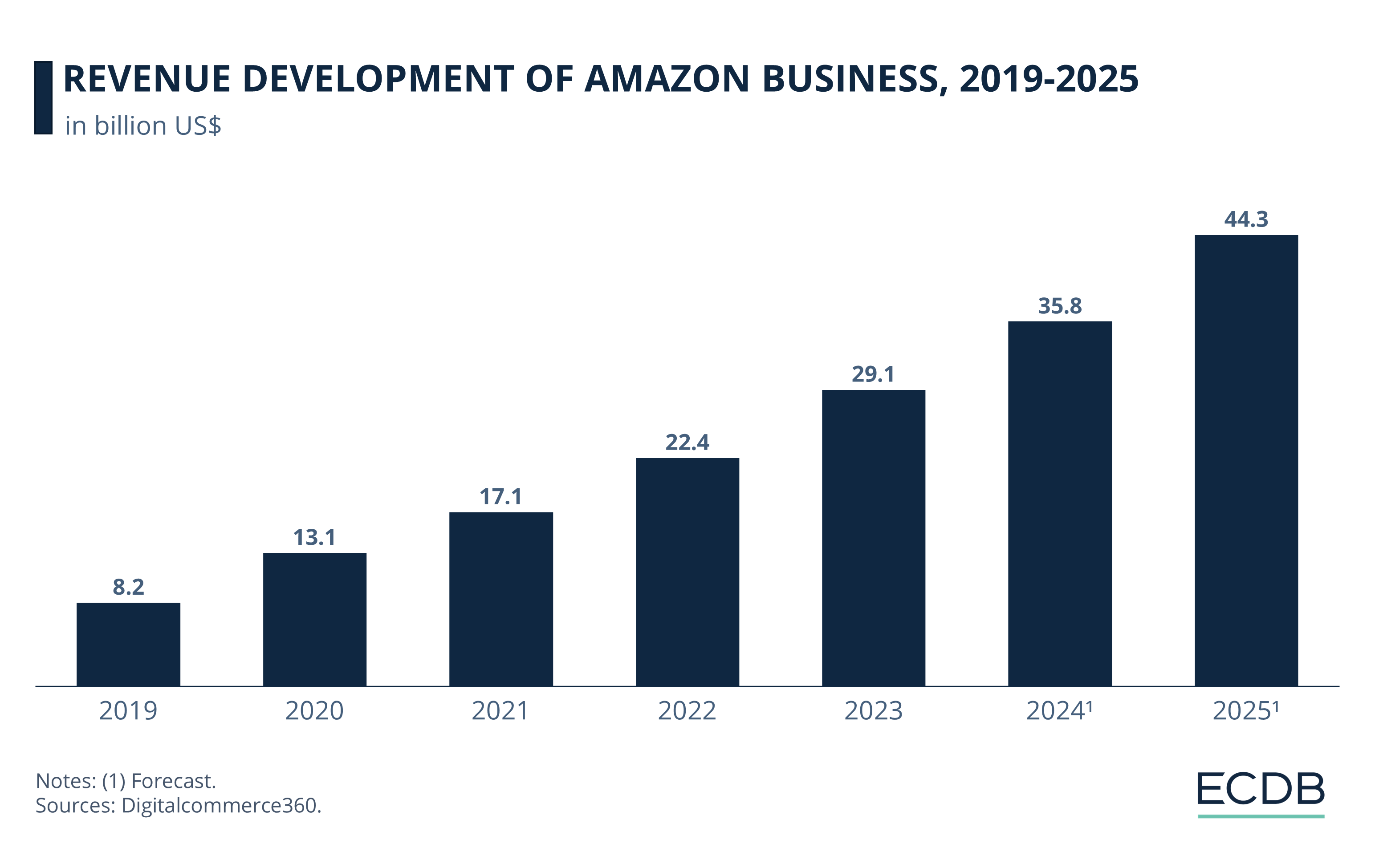
Alibaba is nowhere near what Amazon Business has been generating for years: Amazon Business had revenues of US$8.2 billion before the pandemic, and currently stands at nearly US$30 billion.
The outlook for the coming years is positive, with revenues expected to rise to US$44.3 billion by 2025.
As these two market leaders demonstrate, B2B eCommerce can generate remarkable revenues. Other retailers are jumping on the B2B bandwagon, such as Zalando with its ZEOS fulfillment software or About You with Scayle.
But what is it exactly that makes wholesale eCommerce so profitable?
Benefits of B2B eCommerce
The market GMV of B2B eCommerce reflects the size and revenue potential of this sector. In 2024, it is equivalent to the economic activity of the entire United States.
Valuable Insights: Our data-driven rankings are regularly refreshed to provide you with crucial insights for your business. Find out which stores and companies are performing will in the eCommerce space and which categories are topping the sales charts. Stay ahead of the market with our rankings for companies, stores, and marketplaces.
The benefits of B2B eCommerce are:
1. Scalability & Cost Savings
The nature of B2B business models implies that buyers purchase products in larger quantities than individual customers. This benefits both parties: Sellers can ensure that more of their goods are purchased, and buyers purchase products at wholesale prices, which means they can easily make a profit on resale.
2. Personalization
B2B eCommerce tends to focus on providing buyers with the information and support they need to ensure the highest level of satisfaction with the product. Because of the larger order sizes and longer sales cycles, sellers can spend more time personalizing their offer to meet buyers' criteria.
Data-driven insights into what customers want are becoming increasingly important in B2B relationships. With the advancement of AI technology, the average analytical capabilities of companies are increasing.
Here are the 5 most common types of customer service in B2B companies. Automated live chat has already made it into the top 5.
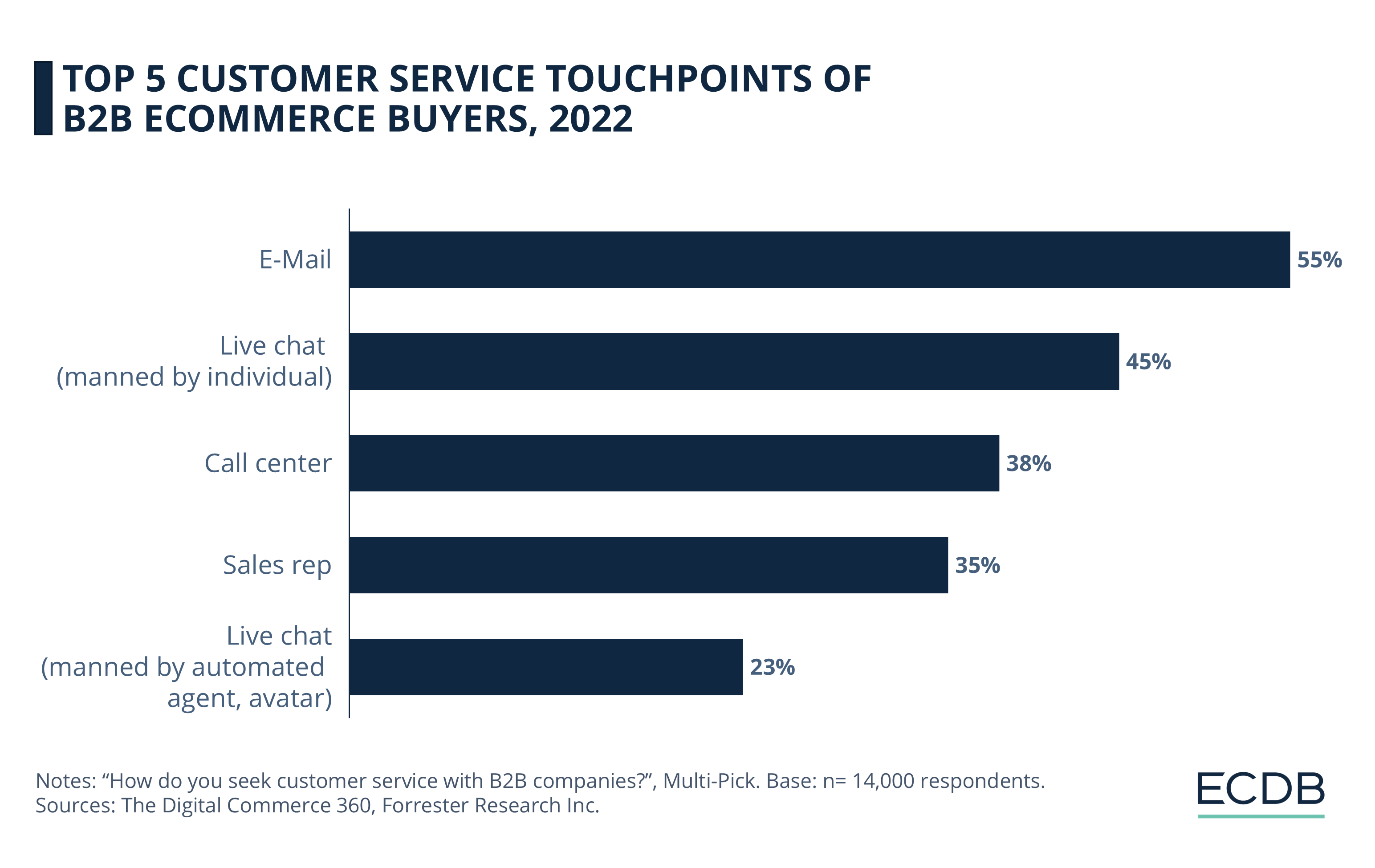
3. Higher Customer Retention Potential
The nature of B2B businesses, due to higher order numbers and more personalization, gives sellers better tools to gauge the reasons why customers might discontinue the business interaction.
In B2C, this is less obvious due to the sheer volume and anonymity of buyers, as customers may simply never return again. B2B is more about building long-term relationships, sometimes based on contracts, which makes it more noticeable when a business partner drops out. Examining the reasons for cancellations can help sellers improve their offerings.
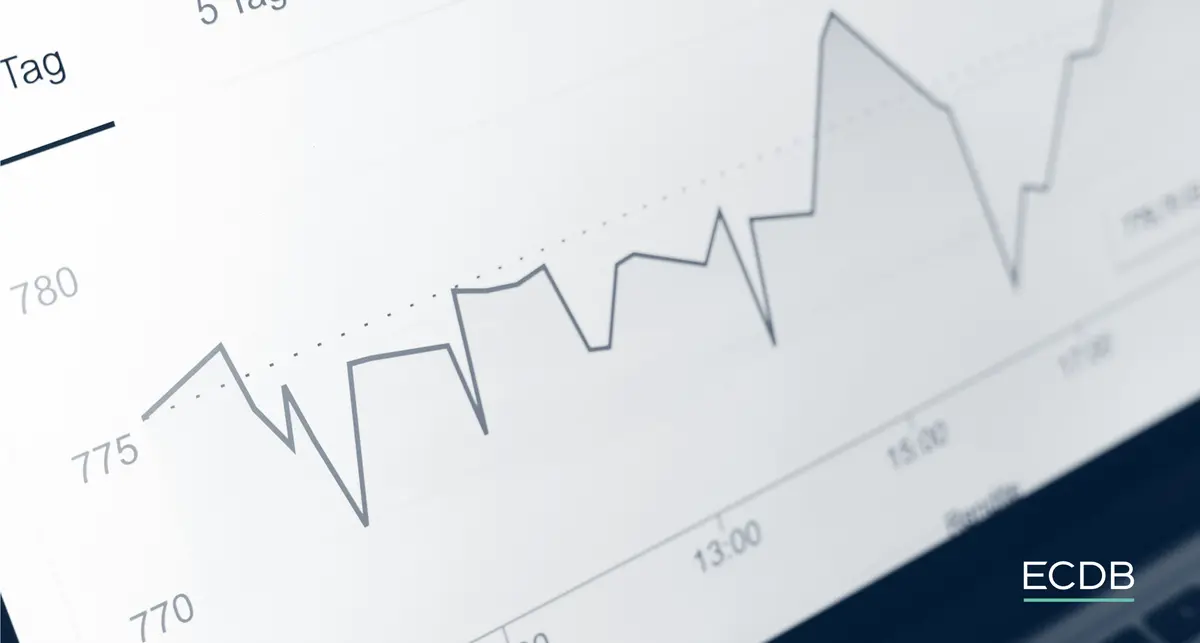
B2B eCommerce Market: Wrap-Up
The business-to-business sector of the online economy is a huge market, generating trillions of dollars in GMV. APAC is a particularly important world region for B2B eCommerce because untapped structures make it easier to build an eCommerce system for businesses from scratch. In North America and Europe, it takes more complex processes to replace old structures.
The benefits of B2B eCommerce include high scalability and lower costs, extensive personalization capabilities, and improved customer retention. B2B can help companies with volatile revenue streams become more stable. In North America, Europe, and the Middle East, the market is expected to continue growing.

Click here for
more relevant insights from
our partner Mastercard.
Related insights
Deep Dive
eCommerce in Canada: Top Stores, Market Development & Trends
eCommerce in Canada: Top Stores, Market Development & Trends
Deep Dive
Top eCommerce Companies by Market Cap 2024
Top eCommerce Companies by Market Cap 2024
Deep Dive
Online Shopping in the United States: Where Consumers Prefer to Shop Online
Online Shopping in the United States: Where Consumers Prefer to Shop Online
Deep Dive
Alibaba Competitors: Which Companies Are Alibaba’s Biggest eCommerce Rivals?
Alibaba Competitors: Which Companies Are Alibaba’s Biggest eCommerce Rivals?
Deep Dive
Temu Is the Second Most Visited eCommerce Website in the World
Temu Is the Second Most Visited eCommerce Website in the World
Back to main topics
